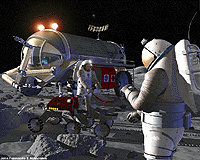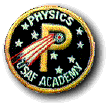| Syllabus For This Week |
|---|
Lesson 26: LAB 5 - Rotational Motion (Double Period)
Reading: Chapter 13 [Sections 3-4],Lab 5 handout
Problems: Chapter 13 [51]
WebAssign Problems: P13.36R, L26-MC
Objective:
- Be able to solve rotational motion problems employing
the principle of conservation of angular momentum.
BLOCK V: Gravity, Orbits, & Atmospheres
Applications: Placing Objects into Orbit; Satellites Falling through the Atmosphere;
Changes of Air Density with Altitude
Lesson 27: KEPLER'S LAWS AND THE GRAVITATIONAL FORCE
Reading: Chapter 9 [Sections 1-2, 5]
Questions: Chapter 9 [3, 5]
Exercises: 9-2 page 217
WebAssign Problems: P9.1R (see Appendix E), P9.8R, L27-MC
Pick Up: The Hot Wheels Theory of Orbits handout
Objectives:
Know Kepler's three laws of planetary motion.
Be able to solve problems using Newton's universal
law of gravitation.
Be able to derive and calculate the acceleration due
to gravity, given the mass and radius of a planet.
Understand the concept of a gravitational field.
Lesson 28: ORBITAL MOTION
Reading: Chapter 9 [Sections 3]; Orbital Theory Handout
Questions: Chapter 9 [4, 8]
Exercises: 9-3 page 220
Problems: Chapter 9 [12]
WebAssign Problems: P9.13R, P9.18R, L28-MC
Objectives:
- Be able to derive Kepler's third law and orbital
speed from first principles for a circular orbit and solve
problems for satellites with a circular orbit.
- Understand that the trajectory of a projectile,
previously approximated as a parabola, is actually an
elliptical orbit with the Earth's center at one focus.
- Understand how orbital speed changes throughout an
elliptical orbit
- Be able to recognize the effective energy diagram for
a planetary orbit and be able to use it to identify
different orbital shapes.
|
| |
|
| Course News |
|---|
|
What is Physics Good For?
This week's "What is Physics Good For?" essay (available here
or via the link on the left hand side of this page) is the one about Gyroscopes and how
angular momentum plays an important role in a gyroscope's ability to keep pointing in a particular direction... take a look!
Next week's "GoodFor" essay will be a new one about one of NASA's satellites, so take advantage of this one now.
Read and find out! Do these short pieces help you gain a bit of perspective on what physics is good for?
Let us know what you think!
Lab #5 (Rotation) is Monday and Tuesday!
A couple of important points:
- The prelab for this lab is electronic -- you turn it in electronically, as a preflight, before the lab.
To complete the prelab, go to the
Preflights, fill in your name in the box on
the left, click the Lesson 26 radio button on the right, and click the appropriate radio button for your normal class
instructor and section (not your lab instructor). Then click the "Gimme a Preflight" button at the bottom of the
page. Please note that you should use Internet Explorer (not Netscape) for this preflight. If you have any problems, please
email your (regular) instructor.
- You will need to download and print the
("Rotation_Lab.doc"),
Lab Worksheet ("RotationWorksheet.doc"), and
Post-lab Assessment ("Rotation_PostLabAssess.doc")
for this lab. Please bring these with you to the lab. These are also available from
the link here or on the left hand side of this homepage.
- The computer people for each section (the people who had the software installed on their computers before the first
lab and brought their computers to the lab) should bring their computers (please!) to the lab. Please also download the
DataStudio software lab template ("Rotation.ds"; needed to acquire lab data using your computer) for the lab so that you are 'ready to go' when you get to the classroom.
There should be at least 4 cadet computers in each classroom. Thanks!
WebAssign News for the Week:
WebAssign Homework Has Changed: As you've probably noticed by now, you're
now required to do via WebAssign only a subset of the problems listed in the syllabus. For each lesson,
you can expect to be asked to do one or two conceptual multiple choice questions and two or three workout problems.
- The multiple choice questions will generally come in a pair and will not be from the textbook.
For each pair of multiple choice questions, you have only 3 submission attempts. This basically gives you one initial
try at each problem, one try to fix anything that is wrong, and then a third try to use after seeking help on anything
you're still unsure of.
- The two or three workout problems are basically like two or three of the problems from the book, but the lettered
parts within the problem may be different. These problems are broken down into shorter steps to help you through the problem-solving
process and to give you practice with problems that are broken into parts similar to the GR workout problem parts. You still
have the usual 8 submission attempts for these problems.
Doing the WebAssign homework:
We've revised these WebAssign problems to help you practice starting from the basics. Please take the opportunity
to try to think about the process you are using to solve these problems. We want you to think about
the important underlying physics and learn a useful and effective process as well as get the
required answers to the specific problems. When you finish a problem, you might even consider writing a sentence or
two that summarizes what you did and how you did it to help you focus on the big picture.
We hope that, by reducing the number of problems assigned per lesson, and by offering you modified problems,
you will feel less rushed and pressured, and you
will be able to start with only equations on your constants and equations sheet as you solve these problems. If you
really want to take full advantage of the homework practice, that's what we strongly advocate.
These are the people in the course chain of command:
- your instructor!
- the Assistant Course Director, Dr Evelyn Patterson (office 2A145, Ext. 3-2370)
- the Course Director, Maj Jody Mandeville (office 2A85, Ext. 3-4245)
- the Director of Core Programs, LtCol Ed Tomme (office 2A111, Ext. 3-2179)
- the Head of the Department of Physics, Colonel James H. Head (office 2A33, Ext. 3-3510).
You may contact or leave a message for any member of the Physics Department by calling Ext. 3-3510.
|
|
| Physics News |
|---|
|
Gravitation In The 21st Century
 This week we start talking about gravitation. An old subject, dating back to Isaac Newton, but very topical
as NASA and other space agencies plan ambitious projects for the 21st century. A NASA exploration team (NexT)
is reporting on these plans at the
World Space Congress
(Oct. 10- 19) at Houston, TX. The congress is held once every ten years. This year's gathering is expected to
bring together 13,000 space experts from around the world.
This week we start talking about gravitation. An old subject, dating back to Isaac Newton, but very topical
as NASA and other space agencies plan ambitious projects for the 21st century. A NASA exploration team (NexT)
is reporting on these plans at the
World Space Congress
(Oct. 10- 19) at Houston, TX. The congress is held once every ten years. This year's gathering is expected to
bring together 13,000 space experts from around the world.
NASA experts will outline their plans for the development of low orbit space to serve a springboard for deep space.
Low orbit space is roughly the area between the Earth and the Moon, and deep space is the environment beyond that
(e.g. Mars and further.)
Of particular interest is the Earth-Moon Lagrangian point L1.
A
Lagrangian point -- also called a
libration point in space -- is a spot at which a small body, under the gravitational influence of two large bodies,
will remain somewhat at rest relative to them. In each system of two heavy bodies - e.g Earth and the Moon -- there
exist five theoretical Lagrangian points.
The Earth-Moon L1 Lagrange point is at a distance of some 200,000 miles from the Earth, or 84 percent of the way
to the Moon. "L1 Gateway, with a habitat for crew occupancy, is a good spot to support a locus of activity. Both
humans and their robotic partners can transform this zone into a bustling hub for testing hardware, supporting
science operations, and as astronaut training ground to prep crews for long-haul sojourns into deep space.
Sites on the Moon, for instance, can be easily accessed from an L1 Gateway." The same goes with travel to
Mars or asteroid targets. Many tasks would be automated. "Science facilities could be deployed, rescued, upgraded
and checked out there by humans and telerobotic systems...or sent into deep space to other libration points throughout
the solar system."
more...
(Link opens in a new window.)
|
| Your Comments |
|---|
|
|
| Factoid of the Week |
|---|
|
99% of the solar system's mass is concentrated in the sun.
|
|
|



 This week we start talking about gravitation. An old subject, dating back to Isaac Newton, but very topical
as NASA and other space agencies plan ambitious projects for the 21st century. A NASA exploration team (NexT)
is reporting on these plans at the
This week we start talking about gravitation. An old subject, dating back to Isaac Newton, but very topical
as NASA and other space agencies plan ambitious projects for the 21st century. A NASA exploration team (NexT)
is reporting on these plans at the